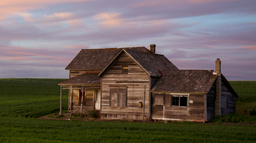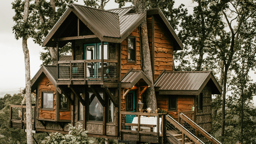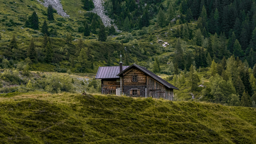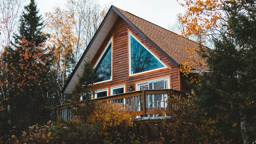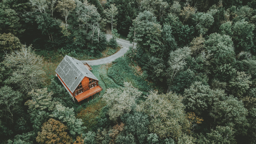
Cabins are capable of withstanding harsh weather conditions year-round, but the winter season poses the most significant challenge. Freezing temperatures, ice and snowfall can damage even the sturdiest home. Winter maintenance becomes even more important if you plan on shutting yours down for the season. Here’s how you can maintain your cabin over the winter months, whether you’re staying there full-time or leaving it until next spring.
Exterior Winterization
You should start by preparing your cabin’s exterior during the fall, well before the winter weather officially begins. Once the temperature drops below freezing for an extended period, outdoor work becomes more difficult. Take the time during October and November to complete these maintenance tasks.
Clean Up the Landscaping
First, you need to clean up your cabin’s landscaping, so it looks presentable throughout the winter. Mow, weed whack and fertilize your lawn in early November so the grass is ready to start growing when spring comes around. If you have a lot of trees on your property, you can use their leaves as mulch during the fall clean-up instead of burning or recycling them.
You should also prune the trees and bushes before the first ice and snow arrive. These types of precipitation add a lot of extra weight and make long branches to droop and break off. Excessive drooping can cause the plants to collapse and die under the pressure. Plus, trimming your plants will prevent animals from nesting in them during the winter.
When you’re done landscaping, drain your gas-powered tools and store them in a dry place. They won’t get touched for at least three months, so you need to leave them in good condition after their final use of the season. Do the same with your lawn furniture, grills and sporting equipment.
Patch Up Air Leaks
Next, you need to perform a thorough exterior inspection of your cabin for air leaks. Take a closer look at the siding, doorways, windows and trim. Patching up air leaks is crucial for keeping your house warm and preventing animals from getting inside. Mice and squirrels are likely to seek refuge in your cabin during the winter.
An inspection will also help you prevent damage from snow and ice. As previously mentioned, they are heavier than they look. Just one foot of fresh puffy snow weighs 4 pounds per square foot or about 6,240 pounds, which is the equivalent of a heavy pick-up truck. You must address any weak spots, so your cabin’s roof doesn’t collapse under the extra weight.
Repair the Roof and Gutters
Cleaning the gutters is the third key task for your cabin’s exterior. Blocked gutters can create ice dams that don’t allow the water to drain, often leading to expensive roof leaks. Yours must be in good shape before winter arrives so they can drain properly and prevent ice from building up. Remove all the leaves and twigs that built up during the fall and fix anything broken.
You can also install a rolled weather guard as an additional waterproof layer underneath your shingles to avoid leaks. Winter precipitation is more destructive than your average rain shower, so you need to take extra precautions.
Interior Winterization
Once you seal up your cabin’s exterior and landscaping, you can focus on winterizing the inside. You’ll spend most of the season indoors, so you can expect to devote more time and resources to this area. These are the most important interior maintenance tasks for protecting your cabin during the winter months.
Inspect Indoor Appliances
Late fall or early winter is a great time to check on your indoor appliances before you start using them more often. Go from room to room and inspect these items:
- HVAC system
- Thermostat
- Light fixtures
- Ceiling fans
- Dishwasher
- Stove and oven
- Refrigerator and freezer
- Washing machine and dryer
Pay extra-close attention to your HVAC system because its workload will significantly increase when winter is in full swing. If you anticipate an especially harsh season, consider getting some energy-efficient heating alternatives to lighten the load on your HVAC system. Space heaters, hydronic heaters and passive solar heaters will keep you warm and lower energy expenses.
If you don’t plan on using your cabin during the winter, remember to unplug or drain all your appliances before leaving. This simple step will conserve energy and eliminate potential fire hazards. You must also remove all perishable food items from the kitchen and store non-perishable items in pest-resistant containers.
Weatherproof Doors and Windows
Your biggest responsibility throughout the winter will be controlling your cabin’s indoor climate. To make this job easier, weatherproof your doors and windows. Fill the cracks with new caulk or draft strips to keep the cold winds outside where they belong. You should also reglaze or replace any loose windowpanes.
Many other small adjustments can make your cabin more resilient to cold weather:
- Reverse the ceiling fans.
- Install heavier drapes to contain heat.
- Open the curtains on sunny days to maximize natural light exposure.
- Frequently vacuum to prevent dust build-up.
- Keep your interior doors open so warm air can move around the house.
- Move furniture away from heating vents for better air circulation.
- Add more insulation to your attic, basement and crawl spaces.
These changes work toward the same goal of sealing out cold air and trapping warm air inside. They can combine to reduce your cabin’s heating and cooling costs by an average of 15% or an average of 11% on total energy costs.
Insulate Your Plumbing
Your cabin’s plumbing becomes vulnerable to freezing during the winter months. The easiest way to prevent this problem is by insulating your water pipes. Just wrap a layer of insulation foam around them and keep the water running as usual. You can expect to save 3% to 4% on energy costs just by doing this simple task.
You must do a few additional plumbing maintenance tasks if you’re leaving your cabin for the winter. Turn off the hot water, empty the water heater, let the faucets drain any excess water and do a last-minute inspection for leaks. Your pipes won’t freeze if water isn’t running through them.
Winter Is Coming
Winter will be here before you know it, so don’t wait another day to start these crucial maintenance tasks. Weatherproofing the exterior and interior in these various ways will allow you to enjoy your cabin’s cozy atmosphere no matter how cold and dreary the season becomes.




